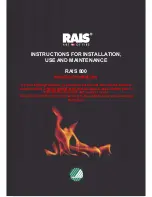
5
VITAE FS V2
– 22-4-16
Maintenance
Annual checking and servicing of the appliance and flue by a competent engineer is recommended.
Ventilation
No purpose provided ventilation is normally required for stoves rated under 5KW. However
for newer build properties or properties that have been modified so that the design air permeability is less
than 5m
3
/h.m
2
a permanent ventilator will need to be fitted. Approved document J of the building
Regulations gives more detailed information. For each KW above 5KW, 550 sq mm of fixed ventilation is
required – i.e. a stove rated at 9KW would require 4 x 550 sq mm = 2200 sq mm of fixed ventilation. If
more than one appliance is installed in the same room, the ventilation requirements for each appliance must
be added together.
There must not be an extractor fan fitted in the same room as the stove as this can cause the stove to emit
fumes into the room.
4.0
Installation Information
Chimney
The chimney height and the position of the chimney terminal should conform to
Building Regulations
. Flue
heights should be high enough to ensure sufficient draught to clear the products of combustion. Check that
the chimney is in good condition, dry, free from cracks and obstructions. The diameter of the flue should not
be less than 150mm and not more than 200mm. If any of these requirements are not met, the chimney should
be lined by a suitable method. The chimney must be swept before connection to the stove.
Where the chimney is believed to have previously served an open fire installation, it is possible that the
higher flue gas temperature from the stove may loosen deposits that were previously firmly adhered, with
the consequent risk of flue blockage. It is therefore recommended that the chimney be swept a second time
within a month of regular use after installation.
If you have any doubts about the suitability of your chimney, consult your local dealer/stockist or chimney
specialist. If there is no existing chimney then either a solid fuel compatible prefabricated block chimney or
a twin-walled insulated stainless steel flue to BS 1856-1 can be used. These chimneys must be fitted in
accordance with the manufacturer’s instructions and also please refer to the current issues of British
Standards BS EN 15287-1:2007 for design, installation and commissioning of chimneys.
Flue Draught
A flue draught of minimum 1.2mm to a maximum 2.5mm water gauge (12 to 25 Pascals) is required for
satisfactory appliance performance. The flue draught should be checked under fire at high output and, if it
exceeds the recommended maximum, a draught stabiliser must be fitted so that the rate of burning can be
controlled to prevent over-firing.
Connection to the Chimney
This appliance is
not
suitable for use in a shared flue. This appliance requires a direct flue connection to the
spigot. If practical, an existing fireplace opening can be bricked up or sealed with a register plate and a short
length of flue pipe of a minimum 150mm internal diameter may then be used to connect the stove to the
register plate in the chimney. This flue pipe should conform to Building Regulations The connecting pipe is
fitted with the spigot pushed up from
inside
the stove and rotated onto its keyhole slots to join to the pipe.
Ensure that the pipe end is no closer than 76mm to the side or rear chimney walls.
If necessary a hole must be opened up into the flue way above the fireplace in order to fit the appliance to
the flue correctly. Please consult HETAS recommended fitting methods if in doubt. It is
essential
that all




































